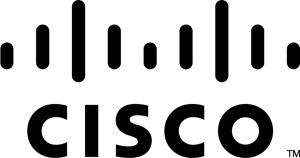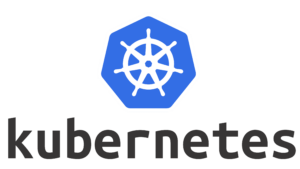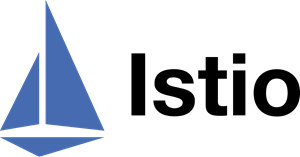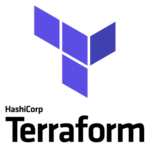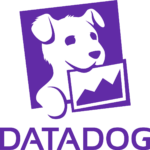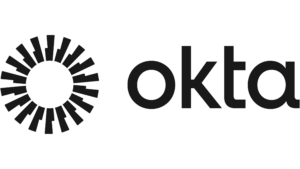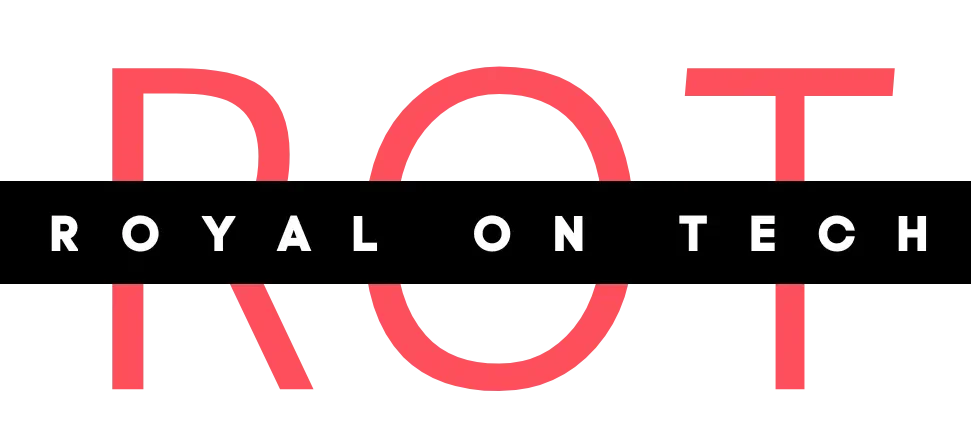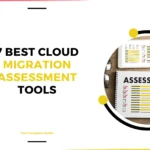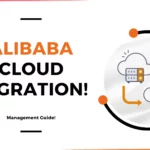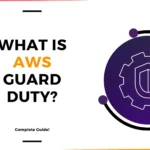For More Info!
Cloud Landing zone
CLOUD LANDING ZONE
The Essential Guide to FinOps: Managing Cloud Costs Effectively
Table of Contents
Intro
Financial operations (FinOps) is an operational framework and cultural shift that integrates technology (For managing operating expenditures [Opex]), business, and finance to enhance financial accountability and expedite business value realization through cloud transformation.
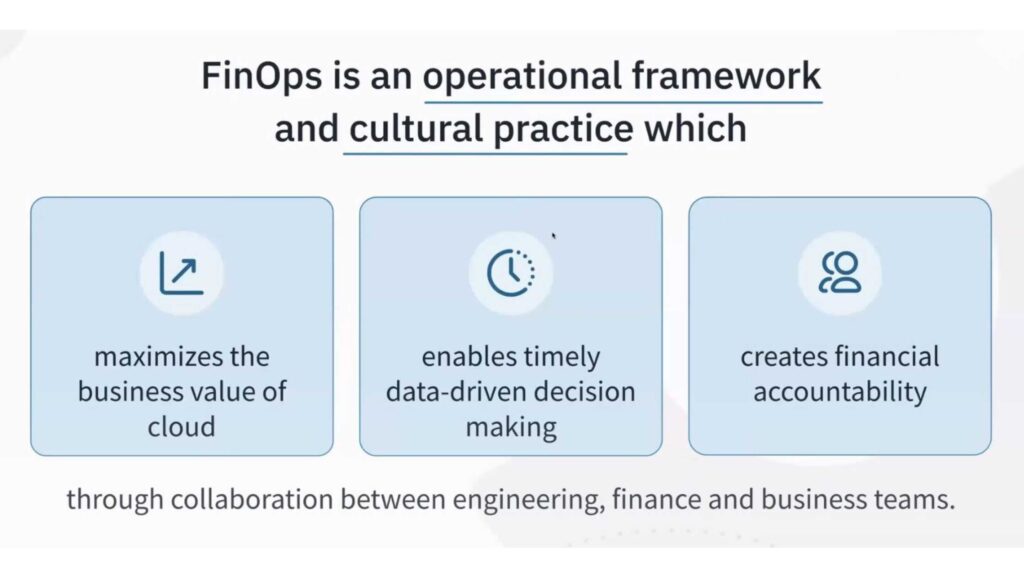
1 - FinOps vs Billing Optimization
FinOps is a cultural shift in cloud management, where teams collaborate to optimize costs and maximize value. It involves cross-functional teams from Engineering, Finance, Product, etc., working together to ensure faster product delivery and financial control.
While Billing optimization is a part of FinOps, which is a comprehensive framework aligning cloud spending with business goals to ensure cost efficiency and effective resource management. FinOps promotes financial accountability and operational excellence in organizations using cloud services.
2 - Benefits of using Cloud FinOps!
Advantageous Early Adoption
Embracing FinOps early on offers significant advantages, as it’s a lasting trend that rewards early adopters. By implementing FinOps, organizations can optimize their technology investments, ensuring they stay ahead in the dynamic cloud landscape and drive digital transformation effectively.
Critical in Economic Fluctuations
In today’s uncertain economic climate, FinOps emerges as a critical tool for organizations to navigate and thrive amidst economic fluctuations. By optimizing IT spending through FinOps practices, businesses can maximize the value derived from cloud technology, ensuring financial resilience and stability.
Key Driver of Digital Transformation
FinOps isn’t just about managing costs; it’s a pivotal driver of digital transformation. By implementing FinOps principles, organizations can leverage cloud technology more effectively, accelerating their journey towards digital transformation and staying competitive in today’s rapidly evolving business environment.
3 - Evolution from Traditional IT
In traditional IT setups, responsibility for finances rested with IT or procurement teams, but cloud technology has changed this dynamic, necessitating a new approach like FinOps to manage costs effectively.
4 - Five Building Blocks of FinOps
Accountability and enablement
Measurement and realization
Cost optimization
Planning and forecasting
Tools and accelerators
5 - FinOps Framework
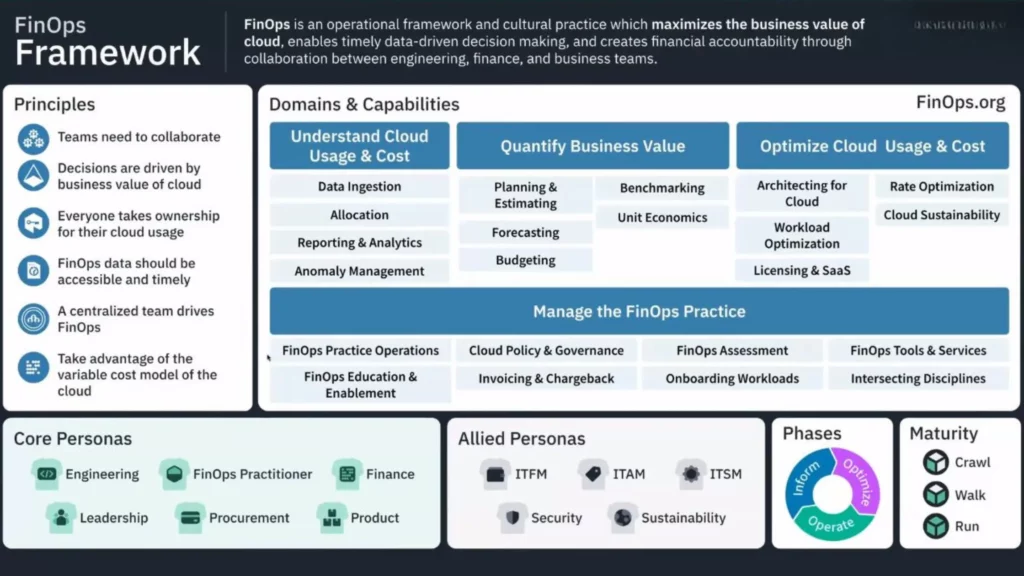
The FinOps Framework serves as a blueprint for mastering the practice of FinOps, empowering organizations to make the most of their cloud investments.
It’s like a roadmap that guides teams in maximizing business value, making informed decisions based on data, and fostering financial responsibility through collaboration among engineering, finance, and business units.

Currently, there are six main components of the FinOps Framework:
1- Principles: These are the guiding values that shape our FinOps practices, ensuring consistency and alignment with organizational goals.
2- Personas: These represent the different stakeholders involved in FinOps, from the teams directly managing cloud resources to the leaders overseeing financial aspects.
3- Domains: These are the core areas of focus that drive tangible business outcomes, such as cost optimization, resource utilization, and performance efficiency.
4- Capabilities: These are the specific activities and tasks performed to achieve the desired outcomes outlined in the Domains. They range from cost monitoring to budgeting and forecasting.
5- Phases: FinOps operates in iterative cycles, where teams go through different phases like planning, implementation, and optimization, continuously refining their practices over time.
6- Maturity Model: This provides a structured way to assess the current state of FinOps within an organization, helping teams understand where they stand and identify areas for improvement.
6 - Framework Explained!
Think of the FinOps Framework as a set of building blocks. Just like building something with LEGO bricks, practitioners can choose and arrange these blocks in various ways, creating unique implementations of FinOps that share the same foundational components.

6.1
FinOps Principles
- FinOps is not just about managing costs—it’s about driving business value, fostering collaboration, and embracing the dynamic nature of cloud computing. By adhering to these principles, we pave the way for success in our FinOps journey.
Details
Collaboration is Key:
- Finance, technology, product, and business teams collaborate in real-time to navigate cloud spending intricacies.
- Strive for efficiency and innovation through teamwork.
Ownership Matters:
- Each team member takes ownership of cloud usage, prioritizing unit economics and value-based metrics.
- Balance cost, quality, and speed to drive better business decisions and foster innovation.
Centralized Guidance, Decentralized Action:
- Central FinOps team provides guidance, while individual teams manage cloud usage within budget constraints.
- Decentralized decision-making fosters accountability and optimization at every level.
Timely Insights Drive Action:
- Accessible, real-time cost data enables informed decision-making.
- Promptly identify and address inefficiencies for continuous improvement and proactive planning.
Business Value Drives Decisions:
- Focus on the business value of the cloud with executive buy-in and alignment with organizational goals.
- Centralize rate optimization and leverage the cloud’s variable cost model to maximize value and minimize risk.
Embrace Flexibility:
- Utilize the cloud’s variable cost model for agile, just-in-time planning and purchasing.
- Prefer agile iterative approaches for proactive system design and continuous optimization over static, long-term plans.
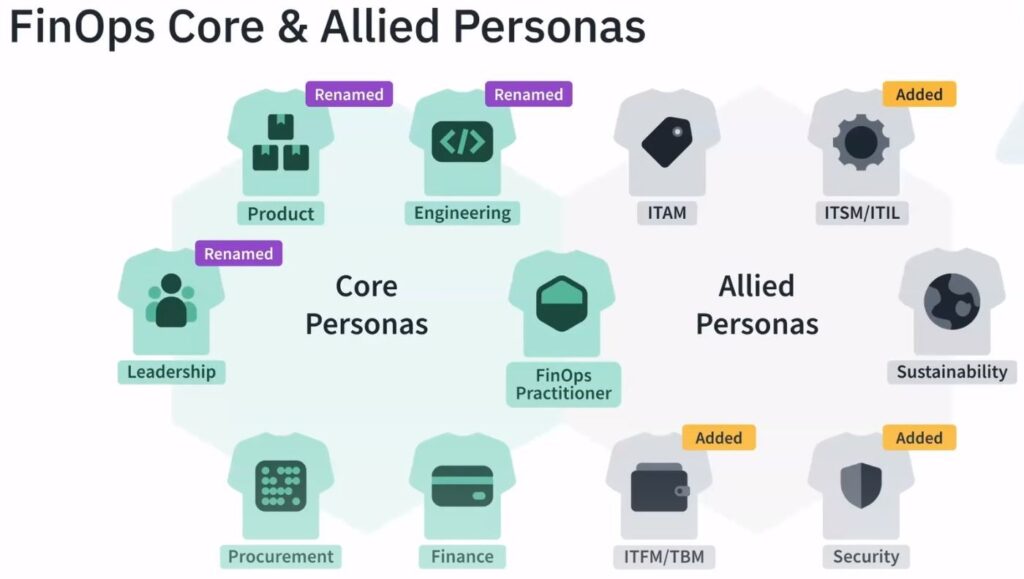
6.2
FinOps Personas
- Each persona brings unique perspectives and skills, contributing to the overall success of FinOps.
- Their roles and responsibilities underscore the importance of collaboration in managing cloud costs effectively and realizing value.
Details
In the world of FinOps, personas represent broad stakeholder groups that collaborate to drive success. While not tied to individual people, each persona plays a vital role in supporting FinOps initiatives within the organization.
Leadership:
- Ensure FinOps initiatives align with business objectives.
- Bridge the gap between cloud technology decisions and strategic goals.
- Drive action to overcome challenges.
Finance:
- Reconcile cloud provider invoices and forecast accurately.
- Budget effectively and ensure transparency of cloud costs.
- Align cloud expenses with financial objectives.
Procurement:
- Procure cloud services and optimize vendor relationships.
- Ensure vendor engagements are cost-effective and compliant.
- Collaborate with FinOps practitioners for successful cloud financial management.
Product:
- Define requirements and prioritize initiatives supporting FinOps principles.
- Engage stakeholders and articulate the value of cloud technology decisions.
- Align FinOps practices with business objectives.
Engineering:
- Design, manage, and optimize cloud infrastructure for cost-effectiveness, performance, and reliability.
- Prioritize security and compliance to meet regulatory requirements and industry standards.

6.3
FinOps Domains
- Each interconnected domain allows organizations to build FinOps capabilities across multiple areas simultaneously, maximizing cloud investment value while promoting efficiency and innovation.
The Key Components of Networking
In the FinOps Framework, domains outline the core business outcomes organizations should achieve through FinOps practices.
Understanding Cloud Usage & Cost:
- Gain comprehensive insights into cloud usage and costs through data collection, categorization, and reporting.
- Make information accessible to all FinOps stakeholders for effective decision-making.
Quantifying Business Value:
- Connect cloud usage and cost data with business value.
- Map costs to budgets, forecast expenses, and establish KPIs.
- Benchmark performance against industry standards and internal metrics.
Optimizing Cloud Usage & Cost:
- Maximize resource efficiency and minimize costs by managing resource types, usage patterns, and pricing models.
- Focus on architecture modernization and sustainability for long-term value.
Managing the FinOps Practice:
- Foster a FinOps culture for continuous improvement and alignment with business needs.
- Enhance collaboration among stakeholders through operational excellence and organizational enablement.

6.4
Capabilities
- These capabilities are essential for organizations embarking on their FinOps journey, enabling them to build a culture of cost optimization, accountability, and innovation in the cloud.
Details
In the realm of FinOps, capabilities represent the functional areas of activity that support each FinOps domain.
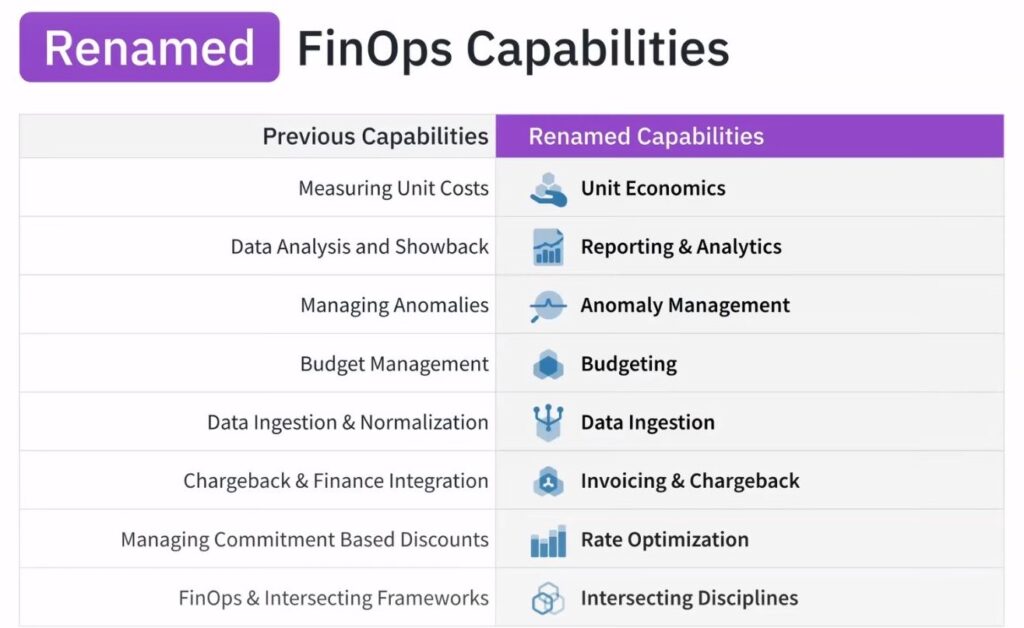
These activities are the building blocks that enable organizations to navigate through the various phases of FinOps implementation.
Enabling and Educating:
- Provide education and resources through training sessions, workshops, and knowledge sharing.
- Ensure teams understand their roles in managing cloud costs effectively.
Advocacy and Knowledge Sharing:
- Promote FinOps practices and knowledge sharing across teams.
- Create forums, communities, and channels for sharing best practices and success stories in cloud cost management.
Actionable Tasks and Business Objectives:
- Translate FinOps principles into actionable tasks aligned with business objectives.
- Set clear goals, define key performance indicators (KPIs), and implement strategies for cost optimization and value realization.
FinOps Maturity Improvement:
- Continuously improve FinOps maturity by assessing current practices, identifying improvement areas, and implementing changes to enhance capabilities.
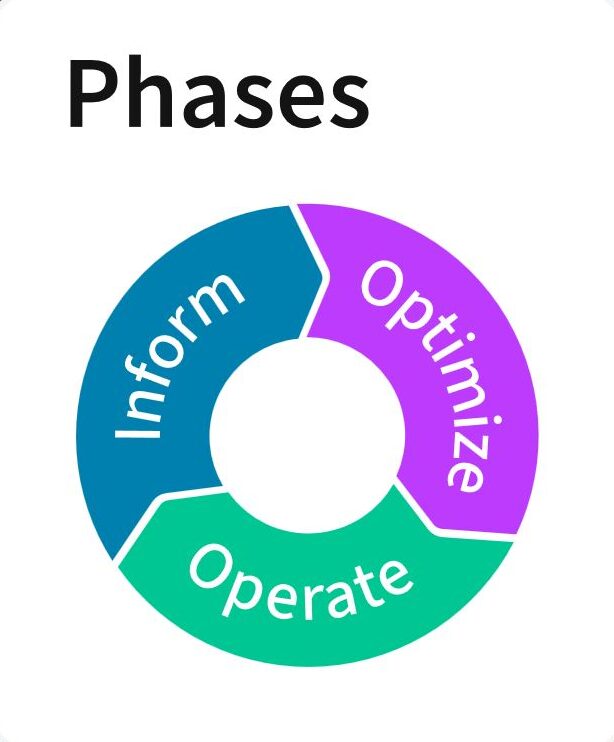
6.5
FinOps Phases
- Throughout these phases, teams iterate on FinOps capabilities, measure results, and make incremental improvements. The ultimate aim is to reduce the time required to cycle through these phases, driving value and efficiency in cloud operations.
Details
Inform:
- Gain visibility, allocation, benchmarking, budgeting, and forecasting capabilities.
- Provide insights into cloud usage and costs for informed decision-making.
Optimize:
- Utilize optimization levers like reserved instances and discounts.
- Rightsize resources and automate shutdown of unused resources to maximize efficiency and minimize costs.
Operate:
- Continuously evaluate business objectives and metrics focusing on speed, quality, and cost.
- Foster a FinOps culture with stakeholder collaboration to define governance policies and align cloud usage with business goals.
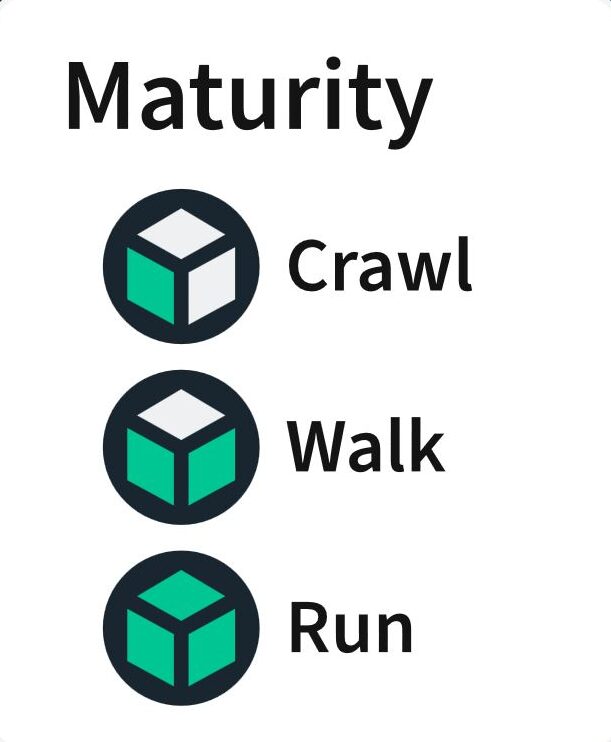
6.6
FinOps Maturity Model
The FinOps journey evolves iteratively, using a “Crawl, Walk, Run” approach. This strategy starts with small steps, gradually scaling as the business value becomes evident. It allows quick action, outcome assessment, and planning for broader implementation.
Details
Assessing the maturity of FinOps capabilities or domains involves identifying where an organization currently operates and pinpointing areas for advancement. Here’s a breakdown of each maturity level:
Crawl:
- Limited reporting and tooling
- Basic measurements provide insights into capability benefits
- Basic KPIs are established for measuring success
- Basic processes and policies are defined, but not universally followed
- Focus on addressing “low hanging fruit” for improvement
Walk:
- Capability is understood and followed within the organization
- Automation and processes cover most requirements
- Difficult edge cases are identified, but not all are addressed
- Medium to high goals/KPIs are set for success measurement
Run:
- Capability is understood and followed by all teams
- Difficult edge cases are actively addressed
- Very high goals/KPIs are set for success measurement
- Automation is widely adopted as the preferred approach
Remember, the goal is not just to achieve a “Run” maturity level in every capability but to continuously improve and align FinOps practices with evolving business needs.
7 - Why Embrace FinOps?
As an engineer, one of the key benefits of FinOps is cost efficiency. Viewing cost as just another metric to optimize the value of your systems demonstrates a high level of cloud maturity and individual responsibility.
Moreover, it directly impacts the company’s bottom line, contributing to increased trust and collaboration among different teams.
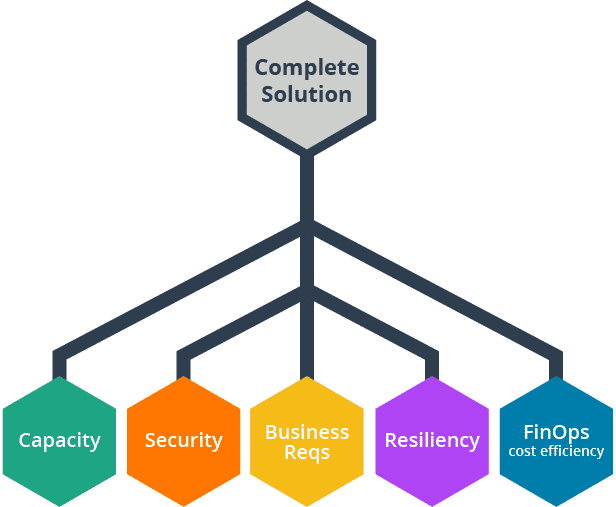
By accurately understanding cloud costs and trends, engineers can improve relationships with other stakeholders and foster an environment conducive to innovation.
Implementing cost efficiency not only saves money for the company but also frees up resources for experimentation, automation, and other initiatives.
The Importance of FinOps
Engineers play a crucial role in delivering business needs through technology. It’s their responsibility to ensure that technology solutions contribute to the overall success of the business.
Just like security, resiliency, and capacity planning, FinOps is integral to building comprehensive solutions.
Motivating Collaboration
Empathy is key for collaboration. Understanding others’ motivations fosters alignment. Explaining tech terms to non-techies builds trust. Sharing engineers’ goals promotes mutual support.
8 - Understanding FinOps Personas
In the world of FinOps, individuals from various levels and departments within an organization play distinct roles.
Each persona is interconnected through the FinOps practitioner, requiring seamless integration for effective collaboration.

FinOps Practitioners:
- Bridge business, IT, and finance teams to optimize cloud usage.
- Champion FinOps culture and empower stakeholders with FinOps Framework principles.
Leadership:
- Drive accountability, transparency, and efficiency.
- Ensure adherence to budgets while maximizing cloud investment value.
Business and Product Management:
- Deliver products addressing market needs and driving positive business outcomes.
Finance:
- Rely on FinOps reporting for cost allocation and forecasting.
- Collaborate with FinOps for accurate forecasting and budgeting.
Procurement:
- Utilize FinOps insights for sourcing and purchasing opportunities.
- Ensure fulfillment of negotiated prices and terms.
Engineers and Ops Teams:
- Focus on building and supporting services while considering costs.
- Engage in activities like rightsizing resources and investigating spending anomalies.
Collaboration across these personas is essential for successful cloud cost management and value realization, highlighting the diverse expertise contributing to the FinOps ecosystem.


8.1
Finance Persona
- Cloud cost management creates friction between finance and engineering. Finance seeks predictability and accountability, while engineering prioritizes agility. Cloud costs are variable and require effort to track.
How FinOps Benefits Finance and Engineering?
FinOps serves as a bridge between finance and engineering, aligning their goals and facilitating collaboration.
The FinOps team plays a crucial role in this partnership, assisting with tasks such as identifying unallocated spend, ensuring budget and forecast accuracy, and streamlining investigations into cloud spend.
Speaking Their Language: Key Finance Terms
To foster collaboration between engineering and finance teams, it’s essential to understand and use key finance terms effectively. Here are a few terms that can help bridge the gap:
-
- Savings versus Cost Avoidance: Instead of using the term “savings,” which may signal to finance that the budget should be reduced, opt for “cost avoidance” to highlight the prevention of unnecessary spend.
-
- Cost Allocation: This refers to the process of splitting up a cloud bill and associating costs with each cost center, helping finance teams track spending more accurately.
-
- Return on Investment (ROI): ROI measures the profit generated from an investment relative to its cost. In a cloud rightsizing scenario, ROI could be calculated as the expected savings in cloud expenditure minus the costs associated with rightsizing actions.
-
- Budget and Forecast: Budget represents the financial plan for a fiscal period and remains fixed, while forecasts predict financial performance over a period of time. Comparing actual costs with forecasts helps determine budget success, with forecasts subject to change based on evolving circumstances.

8.2
Collaborating Across Finance and Engineering
- collaboration between finance and engineering teams becomes essential, despite their infrequent interactions outside of this context.
Collaboration Main Points!
Invoice Management:
- Finance relies on FinOps for invoice details and analysis.
- Engineers provide insights into cloud spend factors.
- Facilitate accurate cost allocation and analysis.
Budgeting and Forecasting:
- Finance seeks expense projections from engineers.
- FinOps develops processes and tools for collaboration.
- Engineer insights enhance forecast accuracy and cost commitment.
Workload Estimation and Migration:
- Engineering collaborates with finance on workload estimation and migration.
- Assess business value of migration efforts.
- FinOps provides insights into commitment-based discounts.
- Evaluate cost-effectiveness with considerations like ROI.
By fostering collaboration at these touchpoints, finance and engineering teams can align efforts, improve budget management, and drive informed decisions.

8.3
Product Owner Persona
- Swiftly introduce new products and features addressing user needs and driving positive business outcomes.
- Stakeholder management and data visibility hindering performance understanding and cost management.
How FinOps Benefits Product Owners!
FinOps Support:
- Helps predict cloud infrastructure impact on product pricing.
- Communicates operational constraints to prevent rework and ensure smoother development.
Speaking Their Language:
- Understanding Cloud Unit Economics maximizes profit through objective performance measurements.
- Calculating marginal cost and revenue enables data-driven cloud investment decisions.
Collaboration with Engineers:
- Engineers regularly interact with product owners, reviewing feature requests and collaborating on solutions.
- FinOps principles considerations in discussions about trade-offs and costs.
Sample Questions for FinOps Conversations:
- How will costs be allocated?
- Can cost-effective technologies alternatives be considered?
- What level of efficiency is necessary?
- What are the application’s costs per user or engineer?
- How will anomalies be managed?
- How can the solution meet finance reporting requirements?
Looking Ahead:
- Brainstorm cost-saving efficiencies to counter rising production costs.
- Maintain product costs and profit margins while delivering new features to users.


8.4
Procurement Persona
- Product owners aim to deliver user-driven features fast, but struggle with stakeholder alignment and data access, making it difficult to manage product performance and costs.
How FinOps Benefits Product Owners?
Managing relationships with cloud platforms, collaborating with engineering and finance leaders to develop strategies for accessing cloud and IT resources.
Process:
- Identifying needs
- Conducting build vs. buy assessments and market analyses
- Negotiating contracts and pricing
- Managing vendors
- Terminating contracts when necessary
Benefits of FinOps for Procurement:
- Securing optimal cloud cost rates
- Ensuring clarity on future cloud usage for negotiations
- Meeting negotiated requirements (legal attestations, financial commitments)
Key Procurement Terms:
- Collaboration: Working with FinOps to develop purchasing strategies and manage procurement processes.
Collaboration with FinOps:
- Setting alerts for high-value third-party purchases
- Supporting engineering with purchases
- Leveraging procurement expertise for cost savings and innovative solutions
Looking Ahead:
Procurement fosters innovation by securing discounts and savings, enabling engineering teams to explore new ideas and solutions. Collaboration with procurement leads to cost-effective and innovative outcomes.

8.5
Leadership Persona
- Leadership, like CEOs, CTOs, CIOs, and CFOs, prioritizes accountability, transparency, efficiency, and budget adherence.
- Cloud spending’s variability can challenge leaders, who seek justification and cost cuts. FinOps bridges engineering and business goals.
How FinOps Benefits Leadership?
FinOps empowers leaders by enhancing accountability for cloud costs and facilitating wise cloud investments. It fosters collaboration and establishes a common language that connects engineering decisions with business outcomes.
Speaking Their Language
Leadership relies on KPIs, NPV, and COGS to set goals and evaluate value. Engineers must comprehend and defend the decisions and forecasts contributing to these goals.
-
- KPIs: Key Performance Indicators gauge organizational success or the effectiveness of specific activities.
-
- NPV: Net Present Value assesses the long-term profitability of a project by comparing expected revenues and costs.
-
- COGS: Cost of Goods Sold encompasses expenses directly linked to production.
Collaboration
Engineers should anticipate understanding organizational priorities and deadlines from leaders. Clear priorities enable informed trade-offs, optimization decisions, and staffing allocations.
Forward Thinking
Friction between leaders and engineers may arise regarding lead time. Engineers can collaborate with leadership to elucidate timelines and processes, aiding leaders in decision-making, particularly regarding optimization strategies.

8.6
FinOps Practitioner
- The primary goal of the FinOps practitioner is to instill best practices within the organization through education, standardization, capability enablement, and advocacy. They often collaborate with the engineering team to access necessary data for cost allocation and accountability distribution.
How FinOps Benefits Organizations?
Utilizing FinOps practitioners aligns accountability to cloud users, making engineers directly responsible for their cloud usage and spending.
These practitioners also enhance confidence in budgets and forecasts while fostering improved communication across the organization.
Speaking Their Language
FinOps teams should ideally communicate effectively with all personas. If understanding or communication issues arise, engineers can seek support from their FinOps partners.
Key Terminology
1 - Commitment-based Discounts
Discounts offered by cloud service providers (CSPs) for committing to use a minimum level of resources for a specified term.
Examples of commitment based discounts include:
GCP “Committed Use Discount” (CUD) for Compute Engine and “Reservations” for BigQuery
Examples of commitment based discounts include:
AWS “Reserved Instance” (RI) for EC2 and “Savings Plans” (SP) for SageMaker
Examples of commitment based discounts include:
Azure “Reserved instances” (RI) for VMs
2 - Chargeback
An allocation strategy sending actual IT service consumption spend from finance systems back to user teams.
3 - Showback Reporting
Presenting IT service costs to user teams without the intent of invoicing them, fostering awareness and accountability.
4 - Fully-loaded Costs
Amortized costs reflecting actual discounted rates paid for cloud resources, factoring in shared costs and organizational structure.
Collaboration
- Collaborate in business decision-making
- Own and manage your usage and costs
- Design and build cost-efficiency solutions
- Tag/label cloud resources
FinOps teams typically drive engineering action on cost avoidance through cultural and governance initiatives.
They collaborate with engineers to promote awareness, manage usage and costs, design cost-efficient solutions, and tag/label cloud resources.
Forward Thinking
Engineers can begin working with FinOps teams to cultivate a “Engineering for Profitability” mindset.
Incorporating a ‘cloud cost impact’ consideration in user story templates can reinforce the optimization mindset.
Final Thoughts
Engineers are the backbone of technical solutions that drive business success. Their role is irreplaceable in meeting organizational objectives while minimizing risk.
Effective communication and empathy towards other stakeholders are essential for engineers to convey the value and cost-effectiveness of their work.
Taking ownership of decisions and solutions is crucial for fostering a culture of accountability and continuous improvement within engineering teams.
In short, engineers not only create technology but also architect the path to business triumph through their innovative solutions and unwavering dedication to excellence.
FOLLOW US
Technology Partners
